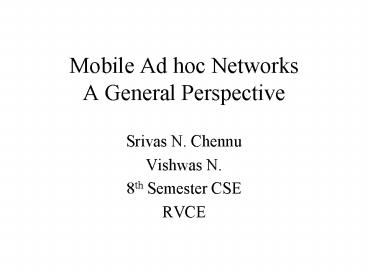Mobile Ad hoc Networks A General Perspective PowerPoint PPT Presentation
1 / 18
Title: Mobile Ad hoc Networks A General Perspective
1
Mobile Ad hoc NetworksA General Perspective
- Srivas N. Chennu
- Vishwas N.
- 8th Semester CSE
- RVCE
2
What Are MANETs ?
- Interconnected collection of wireless nodes
- Nodes enter and leave over time
- Nodes also act as routers forward packets
- No pre-established network infrastructure
- No centralized administration
- Communication using BlueTooth and WAP
3
Characteristics Of MANETs
- Dynamic Topologies and node memberships
- Bandwidth constraints
- Many Transmission Errors
- Energy-constrained operation
4
Where Could We Use MANETs ?
- Industrial and commercial networks
- Anywhere communication
- Military applications
- Robust alternatives to cellular networks
- Wearable and Ubiquitous computing
- Remote satellite - based communication
5
What About Mobile IP ?
Mobile Node in the Home Network managed by Home
Agent.
6
Mobile Node moves to Foreign Network. HA tunnels
packets to FA and intimates Correspondent Node S.
7
A Typical MANET
A
A
B
B
Overlap of Transmission Ranges of Nodes allows
Packet Forwarding
Packets travel over multiple wireless hops
8
MANETs and the Internet
- Future goal seamless net connectivity
- Mobile IP needs to be modified
- Common interfacing between BlueTooth, WAP and IP
- User applications
- Need for handheld and portable computing devices
9
Routing Protocols
- Proactive protocols
- Distributed shortest-path protocols
- Maintain routes between every host pair at all
times - Based on periodic updates
- Reactive protocols
- Determine route if and when needed
- Source initiates route discovery
- Hybrid protocols
- Adaptive Combination of proactive and reactive
10
Proactive Destination Sequenced Distance-Vector
- Each node maintains a routing table
- Next hop, cost metric towards each destination
- Sequence num created by the destination itself
- Each node forwards routing table to neighbors
- Each node increments and appends its sequence
number when sending its local routing table - Routes with greater sequence numbers are preferred
11
- X receives information from Y about a route to Z
- Let destination sequence number for Z at X be
S(X), S(Y) is sent from Y - If S(X) gt S(Y), then X ignores the routing
information received from Y - If S(X) S(Y), and cost of going through Y is
smaller than the route known to X, then X sets Y
as the next hop to Z - If S(X) lt S(Y), then X sets Y as the next hop to
Z and S(X) is updated to equal S(Y)
12
Reactive Dynamic Source Routing Route Discovery
Represents transmission of Route Request (RREQ)
13
Route Discovery in DSR
S
E
F
S,E,F,J
B
C
M
L
J
A
G
H
D
K
I
N
S,C,G,K
- Node D does not forward RREQ, because node D
- is the intended target of the route discovery
14
Route Reply in DSR
S
RREP S,E,F,J,D
E
F
B
C
M
L
J
A
G
H
D
K
I
N
Represents Route Reply (RREP) control message
15
Data Delivery in DSR
DATA S,E,F,J,D
S
E
F
B
C
M
L
J
A
G
H
D
K
I
N
Represents data packet
Packet header size grows with route length
16
Hybrid Zone Routing Protocol
Radius of routing zone 2 Intra-Zone
Proactive Inter-Zone Reactive
17
Current Issues in MANETs
- Security
- Vulnerability of Wireless Links
- MANET node authentication policies
- RSA based encryption using shared certificate
authorities - Quality of Service
- VCs and Bandwidth Reservation
- Dynamic RSVP
18
Conclusion
- References
- E.M. Royer and C.K. Toh, A Review of Current
Routing Protocols for Ad-Hoc Mobile Wireless
Networks - Charles E. Perkins, Mobile IP Design Principles
and Practice - S. Corson J. Macker, Mobile Ad hoc Networking
(MANET) Routing Protocol Performance Issues and
Evaluation Considerations RFC 2501

